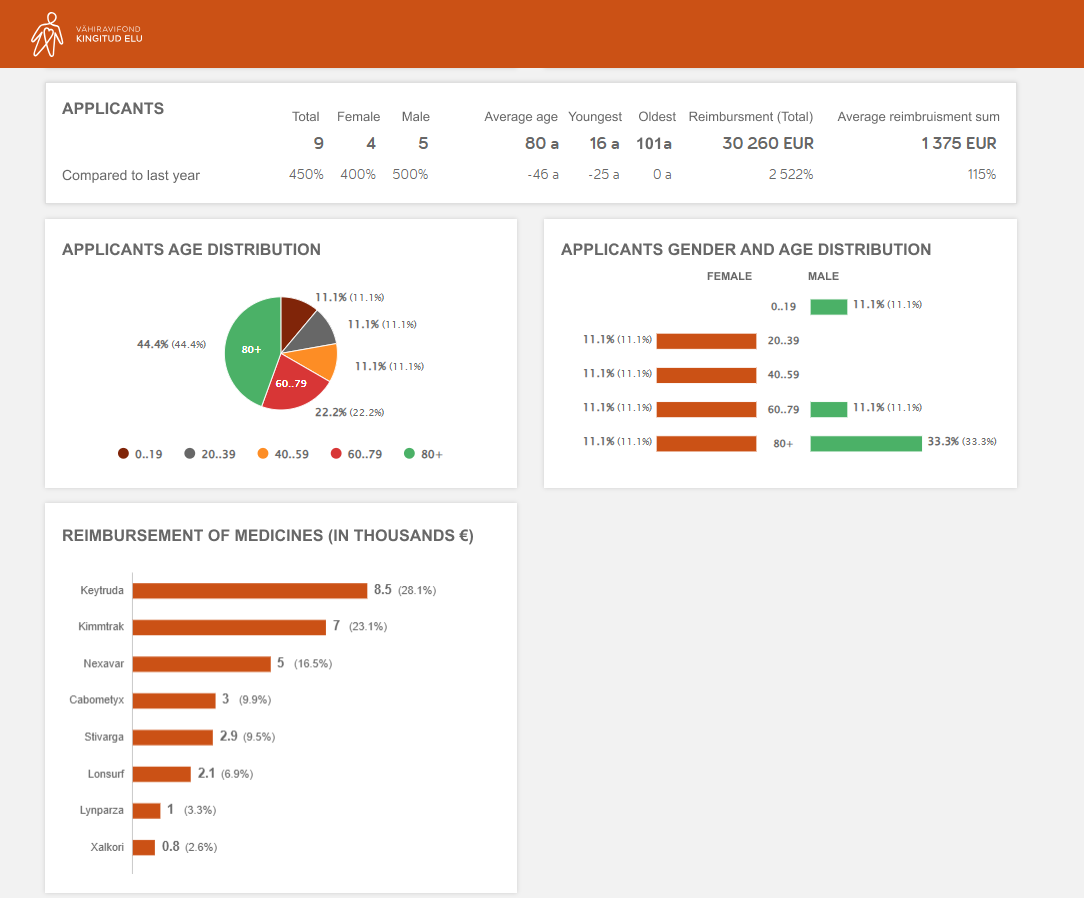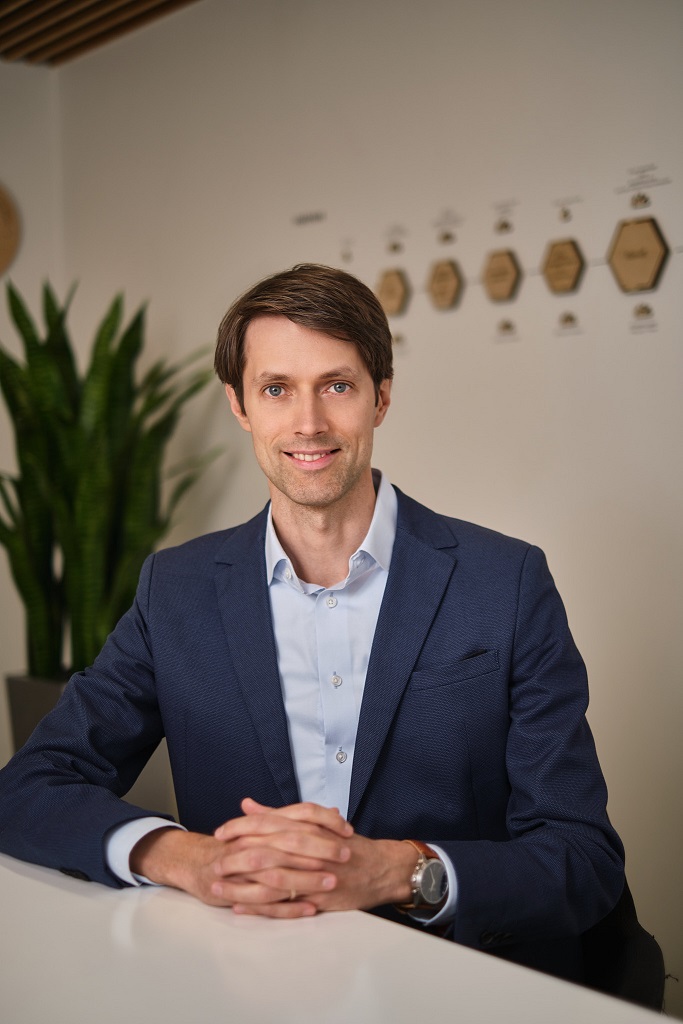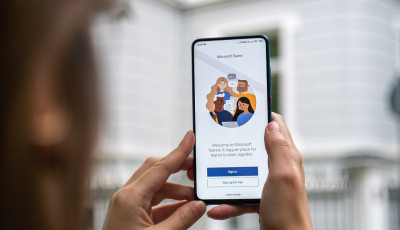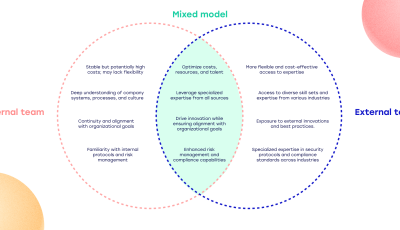It took three years and more than 1,600 pro bono work hours for one very special project to come together – this is the story of the new back-office portal developed by Helmes for the cancer treatment support foundation ‘The Gift of Life’ in Estonia. The system helps the foundation process applications for support faster and allocate resources more efficiently, while the patients requiring help can now easily submit and sign their applications online.
Read more about the deeply meaningful collaboration and our mission of building software for good from the blog post.
Despite their small team, ‘The Gift of Life’ cancer treatment support foundation is one of the largest charities in Estonia. Since its launch in 2014, the foundation has helped more than 2,500 people and raised over €22 million. Its mission is to aid cancer patients whose treatment is not covered by the state Health Insurance Fund. Donations fund the foundation and help patients purchase modern medications or treatment procedures recommended by their doctors but not considered cost-effective by the state. By doing so, the foundation gives cancer patients hope and a chance to live longer or recover completely.
The foundation receives an average of 30 new monthly applications from patients whose treatment options, covered by the state Health Insurance Fund, have run out. With the workload increasing over the years, the team realized the need for a better IT tool to manage the application process and available resources more efficiently.
In 2020, the foundation started searching for a development partner ready to develop the new IT system pro bono. Helmes decided to support ‘The Gift of Life’ on their mission, and since then, 10 Helmes team members have contributed more than 1,600 hours to the project.
The solution at a glance
The new browser-based portal reduces manual work for the team and simplifies the application procedure for patients applying for support.
- Previously, the patient was required to download a PDF application and return it to the foundation by mail or email. However, with the introduction of the new online system, they can quickly fill in an online form, sign it digitally, and submit it with one click. This simplifies and speeds up the application process and guarantees that the applicants provide all the necessary information.
Inside the foundation, the portal has three main user roles:
- The head of the foundation can see applications in various stages – new, pending, and approved. Whenever a new application is received, the system sends an alert if any important details are missing so they can request additional information from the patient or their doctor. If the information is complete, they send the application to the next stage, a review by a panel of doctors. Once medical experts have approved the application, it is returned to the foundation head, who can now issue a letter of guarantee for healthcare institutions and earmark funds necessary to cover the treatment.
- The board of doctors uses the system to review, comment, and vote for or against financing an application. A group of oncologists reviews each application, and the new system considerably speeds up the process. Once three doctors have approved an application, it automatically moves to the next phase.
- Accountants can access invoices received from healthcare institutions and export them into accounting software. They don’t see the health records – only data relevant for accounting purposes.

Benefits of the portal
When helping cancer patients, the speed and efficiency of allocating resources are crucial. The new portal helps the team do back-office work more efficiently in the following ways:
- Speeding up the application process by reducing manual workflow. The system dramatically minimizes the manual work involved in the foundation’s everyday activities. All application forms are received in a predefined digital format, so the team doesn’t have to enter any data manually, and there is less need to ask for additional details. All documentation is accessible in one place instead of juggling between different Excel documents and email folders.
- Efficient and transparent allocation of resources. One of the portal’s goals is tracking available resources, such as incoming donations and expenditures. The necessary sums are automatically earmarked whenever an application gets approved. The head of the foundation has an overview of all commitments and can ensure no overspending or idle resources. (For instance, if an invoice for an approved treatment has not been received within an estimated period, the system automatically notifies them so they can check the situation and, if the treatment has been discontinued, allocate the resources to another patient.)
- Faster and simpler workflow for the board of doctors. The doctors can easily vote on applications and communicate with each other in the same system if needed. Built-in checks ensure that no application gets stuck in the process. (For example, if a doctor has not cast their vote in three days, they are automatically alerted in the portal and by email that their action is urgently required.)
- Secure handling of sensitive health records. The modern technical solution ensures that all the data is stored securely and automatically deleted after the treatment has ended or a period specified in the law has passed. There is no longer any need to send sensitive health records by email.
- Enhanced data collection and analytics. The system standardizes all data collection, and a robust data analytics platform is being built as the next step. For instance, the team can, in the future, analyze the demographics of the applicants or which particular drugs are financed. They can calculate the gap in the healthcare system filled with the foundation’s help and, ultimately, the number of years gifted to patients. They can also study how many donations come from private individuals and companies, the average size of donations, the impact of campaigns on incoming contributions, and much more.
Key insights from the project
The project was a very special one for us and equipped us with several insights about successfully delivering non-profit development projects.
Even though the project was unpaid, we approached it from the start like any paid project, applying our usual Helmes Way approach. First, we designed an MVP (Minimum Viable Product) and conducted a preliminary analysis, then estimated the project scope before embarking on the actual development in our customary agile manner.
We conducted weekly client meetings, regular stand-ups, and check-ins inside the team and asked the foundation to carry out testing and other assignments just like our other clients. Throughout the project, we witnessed first-hand how important sticking to the usual rigor was for the project’s progress, as otherwise, things could easily get delayed or stuck.
We also saw the importance of getting all stakeholders at the table for the project’s success – just like in any paid client project. For example, we included accountants who work pro bono for the foundation on top of their everyday work at Ernst & Young in the development process. This allowed us to consider their specific needs and proved to be crucial for the success of the project.
Inside Helmes, we formed the project team on a volunteer basis from colleagues whose eyes lit up at the opportunity to contribute to the project and who found it a profoundly satisfying experience. We intentionally built a cross-team task force to ensure the project’s success was not dependent on any particular team’s schedule. We’re proud to say our in-house ‘promotional tour’ attracted more interest from colleagues than we could incorporate, so we also had a backup resource at any moment.
Finally, we were delighted to see the willingness of other companies to jump on board and contribute to the project. For example, eIDEasy and Microsoft gave their services free of charge or at heavily discounted terms.
Software for good
Our three-year pro bono collaboration with ‘The Gift of Life’ has shown that our input can make a big difference, and the project has been deeply meaningful and emotionally rewarding to all team members contributing to it. We are proud that the platform helps the ‘Gift of Life’ team help patients more efficiently, and we remain committed to supporting the foundation with ongoing maintenance and further development of the system.
Deniss Ojastu, Partner and Head of Business Area at Helmes: “Public health is one of the areas to which Helmes, as a company, wants to contribute more to give back to society. Our act of charity is not about handing out money but about helping through meaningful collaboration on what we do best – how to make work more people-centered and efficient with digital solutions.
“A long-term software project requires much more commitment, but the results are worth it. For pro bono projects, we look for partners with significant influence and a strategic view in their field. The Cancer Treatment Foundation is undoubtedly an ideal partner, with a strong vision and extensive reach. Working together, we are delighted to be able to help so many people. The project has also been very inspiring for our staff.”
Find out more
You can learn more about the foundation’s activities and possibilities to contribute to its mission on its website: https://kingitudelu.ee/en
If you’d like to dig deeper into the technical side of the project, contact us through the form below.
Get in touch




